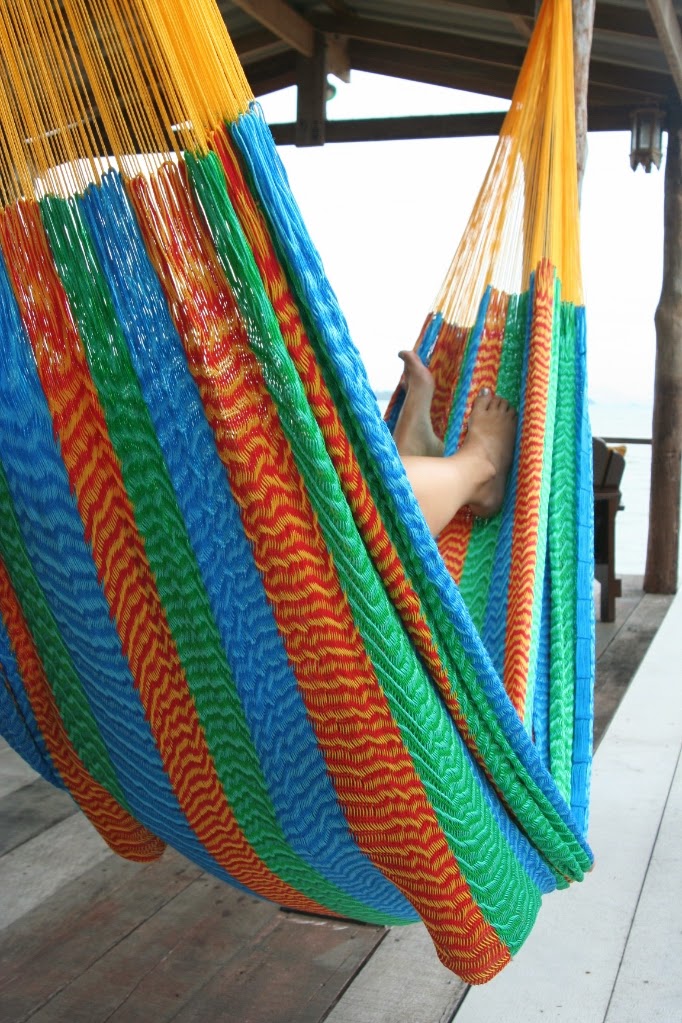Breakfast this morning was an assortment of leftovers from the fridge, fried and tossed into a bowl with soy sauce.
For a mix of rice, beansprouts, Chinese leaf, and a boiled egg, it was surprisingly appetising. We ate the rice bowls sat on the deck looking out to sea. On the deck there are a few heavy wooden chairs (weight is important as lighter furniture would blow away as the stronger winds come in off the water), but other houses have strung up hammocks. These seem in keeping with the relaxed Thai atmosphere in Old Town.
Just then, a voice could be heard from the far end of the house, which gives onto the street. Railing against years of British upbringing, our door remains open for much of the door. This required no small amount of re-education, coming from British society, which for years has shown at best an aversion to, and at worst a mistrust of, chance encounters with one's neighbours. In Lanta Old Town, a Cameronian idyll of 1930's village life still exists. Doors remain open to show that the inhabitants are amenable to guests. Many of the houses double as shops and so it is not unusual to find several generations of a family congregating on the porch. Those that live away from the main street do the rounds selling som tam, coffee, or fresh vegetables, ringing a bell to alert residents to their presence.
The voice at our door, faintly heard from the back of the long Chinese-style wooden house, belongs to our host. She was paying a visit to drop off two jumbo hammocks for the deck. Bought in Mexico at a fraction of the Thai cost, the multicoloured woven string mesh came with a couple of lengths of rough rope and needed somehow to be suspended from the posts outside. We all looked at one another and, having ascertained that none of us had hammock hanging experience, I took upon myself as the make of the group to lash the rope to the wooden supports.
Desperately trying to recall the hard-won knowledge of Scouting knots, I set to work. Feeling under scrutiny from the neighbours - sailors and fishermen - who most certainly known their bowline from their clove hitch, I attached the hammock loops in a rudimentary fashion. Gingerly easing my weight into the fabric, the fastening shot across the beam, almost depositing me on the ground. It was clear a different strategy was required.
Our host returned with a handful of 'S' hooks, which changed the game slightly. After much cursing and viewing of 'helpful' videos on YouTube (whose banter-to-useful-content ratio was far too high), I was none the wiser. There are at least a hundred-and-one ways to hang a hammock, none of which seemed to apply to the precise combination of equipment and environment with which in was faced.
In exasperation, I decided that too much knowledge in this case was a Bad Thing and (somewhat ashamedly) tied the simplest knot I could remember - a reef knot around the joist and support - and attached the hammock loops using the S hooks.
The problem was solved through 'underthink'. The hammocks were quickly removable in case of a storm and supported our weight solidly. Now it was just a matter of how sit comfortably in one. Perhaps YouTube has a handy video...
Returning to more familiar territory in the kitchen, I put together a dinner of some fancy mixed rice we picked up, with a relatively dry green tofu curry, plus Thai aubergines in tao jiew (yellow bean sauce, เต้าเจี้ยว). The slight sweetness imparted by the curry paste was complemented nicely by the salty savoriness of the aubergines.
Hankering after a G&T, having been offered one the other day at a friend's house, but unwilling to shell out for imported gin, I proposed that we sample a little of the local liquor.
Lao khao (เหล้าขาว), or rice whisky, is apparently produced by distilling rice 'beer'/'wine', known as sato (สาโท). It comes in a brown bottle, found in many shops including the 7-Eleven, and has a range of coloured labels - green, blue, yellow and red. We were told that these denote different alcohol percentages, and picked up a 30% ABV.
The shop staff and customers were incredulous that we would buy such a drink. "You will become very drunk", they said. We promised not to let our inebriation get the better of us and mixed up a 'lao khao thonikh'. Taken neat, we found the rice whisky to be fruity, like a smooth Japanese shouchu. In the mixed drinks, its flavour was a little overpowering when compared to the usual gin botanicals, but pleasant when cut with some lime.
Having expected some rough grog, it was worryingly quaffable and, at almost a quarter of the cost of gin, it is easy on the pocket. Oh dear.




No comments:
Post a Comment